正在加载图片...

xi PREFACE TO THE FOURTH EDITION of use to researchers who are starting out in the field.This fourth edition has been updated to include the latest research tools (such as tES.transcranial electrical stimulation)and the latest research methodology(such as multi- voxel pattern analysis.MVPA.in fMRI research). Chapters 6 to 16 outline the main theories and findings in the field.I hope that they convey something of the excitement and ontimism that cu exists.This fourth edition r sents a substantial update.The order of the on (as it deals with general issues relating to brain structure and function).These chapters were also extensively updated to take into account the pid changes in this field.notably the links with genetic methods and cor anectomics Vision and consecutive ch apters (Chap s 7 and 8).which link well to The cha on at entio d added for the first time ula (Chapte magnetoencepl Ch nal hear-1 (Chapter4, visual imagery (C parieta oDbioiogiceal orimotor transformatic on (Chapte and production (Chapte dyslexia (Chapter 13)and the neuroscience of racia ses(Chapter 16). In add o.hve crayof coiv (www.testableorg/ward)with test Rezlescu.Within the textbook,we provide more guidance to web resources via new feature the text,as well as via our dedicated webpage (www.routledge.com/cw/ward). Jamie Ward jamiew@sussex.ac.uk Brighton,UK,March 2019xii PREFACE TO THE FOURTH EDITION of use to researchers who are starting out in the field. This fourth edition has been updated to include the latest research tools (such as tES, transcranial electrical stimulation) and the latest research methodology (such as multivoxel pattern analysis, MVPA, in fMRI research). Chapters 6 to 16 outline the main theories and findings in the field. I hope that they convey something of the excitement and optimism that currently exists. This fourth edition represents a substantial update. The order of the chapters has been changed to bring development much earlier on (as it deals with general issues relating to brain structure and function). These chapters were also extensively updated to take into account the rapid changes in this field, notably the links with genetic methods and connectomics. Vision and hearing are now consecutive chapters (Chapters 7 and 8), which link well to the following chapters on attention and action. The following topics have either been added for the first time or extensively updated: network versus modular approaches (Chapter 1), magnetoencephalography (MEG) (Chapter 3), functional near-infrared spectroscopy (fNIRS) (Chapter 4), visual imagery (Chapter 7), parietal lobe mechanisms of sensorimotor transformation (Chapter 10), recent neurobiological models of speech perception and production (Chapter 12), developmental dyslexia (Chapter 13) and the neuroscience of racial biases (Chapter 16). In addition, we have created a demonstration library of cognitive tests (www.testable.org/ward) with thanks to Constantin Rezlescu. Within the textbook, we provide more guidance to web resources via new feature boxes in the text, as well as via our dedicated webpage (www.routledge.com/cw/ward). Jamie Ward jamiew@sussex.ac.uk Brighton, UK, March 2019